Split rock succulents are one of the most unique succulent species. Named for their rock-like appearance, these low-maintenance plants are an eye-catching addition to any indoor garden.
If you’re looking for an exciting and unique addition to your succulent collection, split rock succulents might just be the perfect choice for you! Here are some of our favorite varieties.
1. Pleiospilos nelii
The Pleiospilos nelii is a true split rock succulent, boasting the name that so many plants are categorized under. In addition to owning the “Split Rock” moniker, one of its nicknames is the “Living Pebble.” This plant is native to South Africa.
The Pleiospilos nelii boasts gray-green leaves with lines and grooves. When it blooms with a stunning yellow-orange flower, the effect is similar to a blossom pushing its way through the concrete.
Like its close relatives, this succulent thrives in bright indirect sunlight and requires infrequent watering. Propagate this succulent via offshoots or leaf cuttings.
While many consider Pleiospilos nelii the proper split rock succulent, many other members of the family Aizoaceae bear this honorary title.
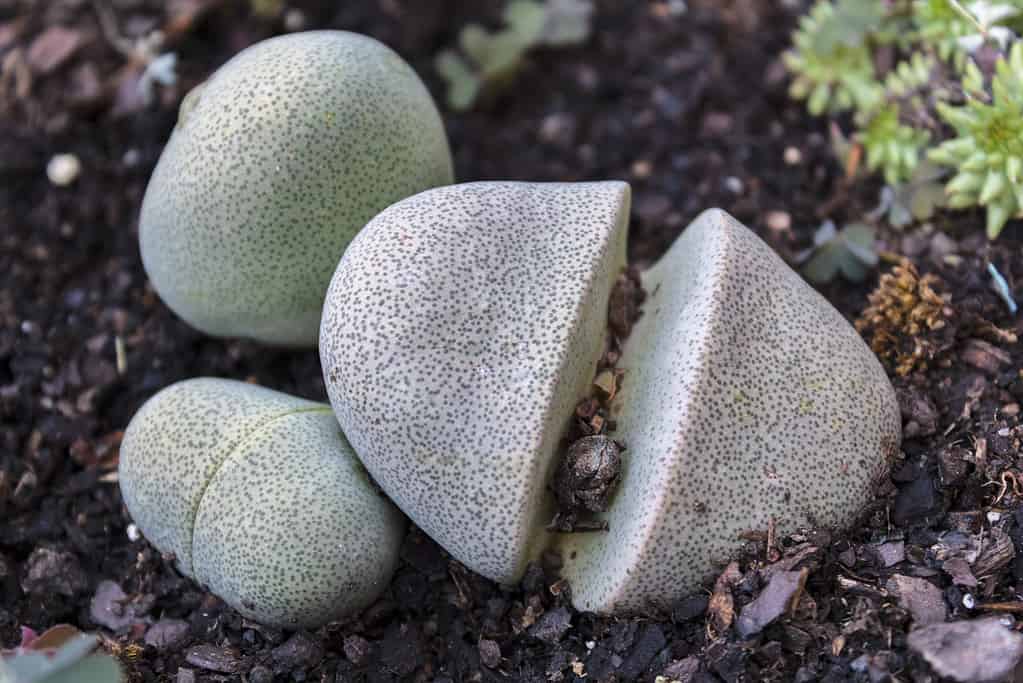
The split rock succulent
Pleiospilos neliialso bears the nickname the”Living Pebble.”
©iStock.com/rfranca
2. Lithops optica ‘Rubra’
Also known as “Living Stones” or “Flowering Stones,” members of the Lithops genus are a colorful take on the split rock name.
Native to South Africa, the ‘Rubra’ takes its name from its red coloration. The plant is small and compact, with two thick, fleshy leaves fused together to form a single, flattened body.
When this succulent blooms, its daisy-like flowers reach 6 inches tall with bright red flowers. The Flowering Stone has evolved to self-pollinate, making it ideal for indoor growth. This succulent prefers bright, indirect sunlight and well-draining soil. You can propagate it through offshoots and leaf cuttings.
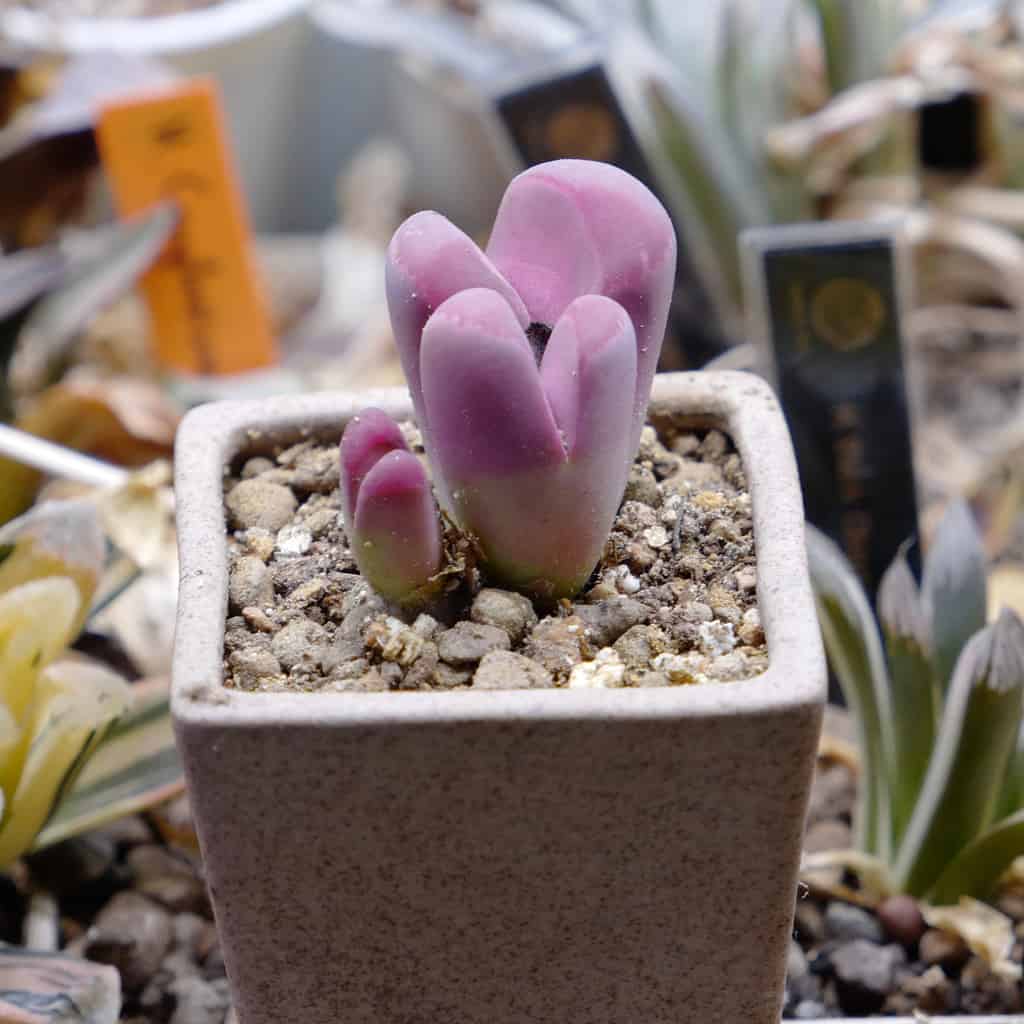
The succulent
Lithops optica‘Rubra’ named for its red coloration, has two thick fleshy leaves fused together to form one flattened body.
©Mongkol Thanapattanapongs/Shutterstock.com
3. Lithops karasmontana
Another living stone, this version has unique, speckled leaves. Its shape is nearly identical to the Lithops optica ‘Rubra,’ and it also grows in South Africa and Namibia. One of its nicknames is the “Karasmontana Stone.”
The key difference lies in the grayish-green leaves with red dots or “fracture lines.” This Lithops blooms yellow or white flowers reaching 6 inches tall in the summer, making this split rock succulent a real showstopper.
This succulent prefers bright, indirect sunlight and well-draining soil. You can propagate it through offshoots and leaf cuttings.
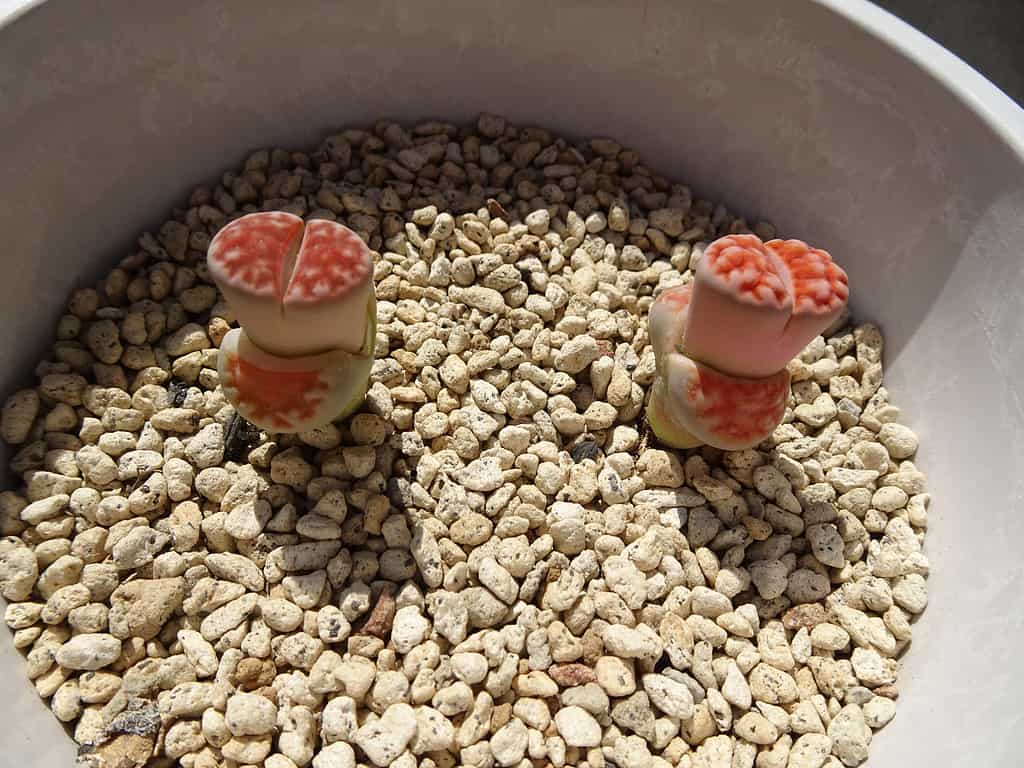
The living stone succulent
Lithops karasmontanahas grayish-green leaves with red dots known as “fracture lines.”
©iStock.com/kazumi miyamoto
4. Lithops dorotheae
Another “Living Stone,” the Lithops dorotheae is also called the “Dorothea’s Lithops.” This intriguing plant evolved to look like stones found in its South African home to deter pests from invading.
Its gray-brown leaves are thick and fleshy, with a connected bottom and fissure in the center. They have a rough texture and distinct markings to help them camouflage with their surroundings. The Lithops dorotheae produces a bright yellow bloom that’s similar to a dandelion. These small succulents look great bunched together in a terrarium or shallow dish.
This plant is so good at conserving water that it can go for months without being watered, making it an excellent choice for beginners. Give this unique split rock succulent bright, direct sunlight and well-draining soil. Propagate by separating offsets or by leaf cuttings.
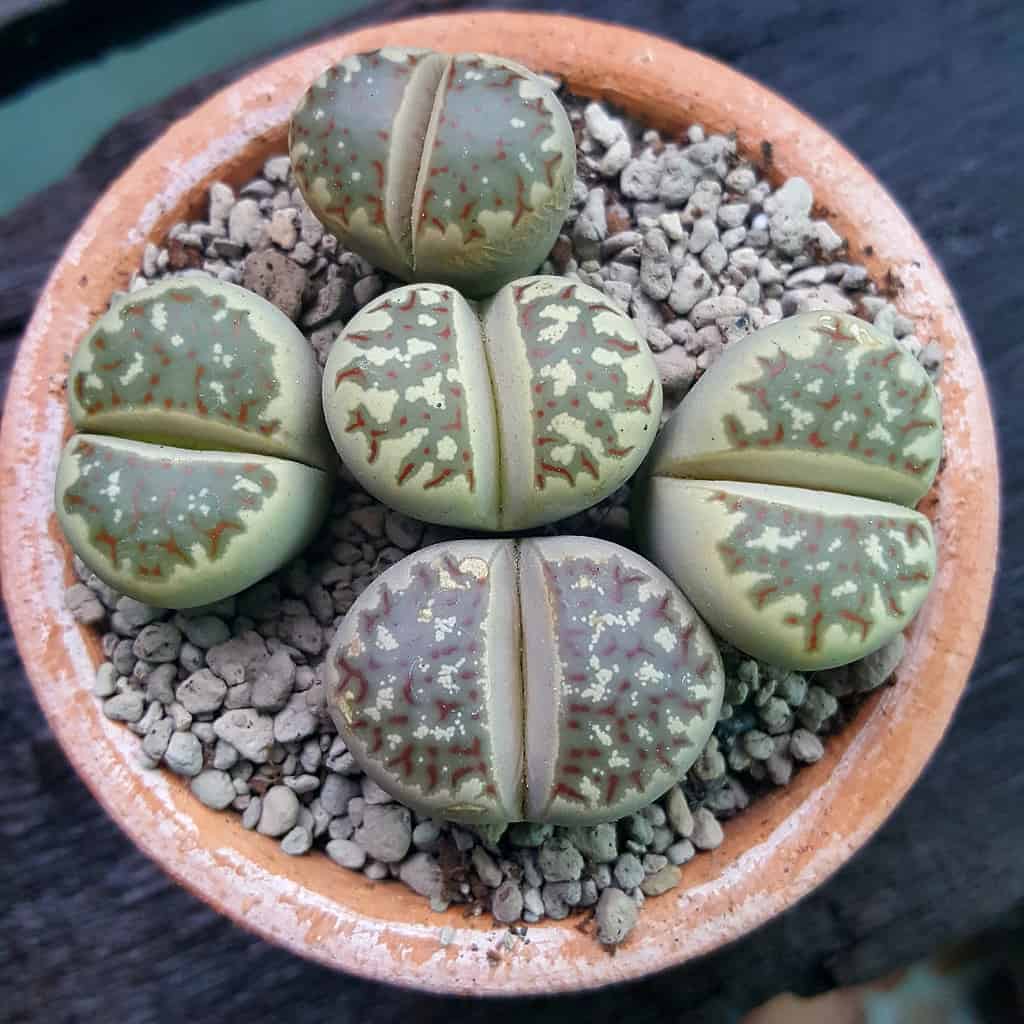
The fact that
Lithops dorotheaecan go months without water makes it an ideal succulent plant for beginners.
©iStock.com/Nutsara Rukbangboon
5. Lithops aucampiae
Lithops aucampiae, also known as the “Mountain Lithops,” is a small but mighty succulent that also hails from South Africa. Like other Lithops, this stunning plant is a master of disguise, with its unique leaf markings and patterns designed to mimic the surrounding rocks and pebbles in its natural habitat.
What sets the Mountain Lithops apart from similar split rock succulents is the color variations. It’s not uncommon to see a collection of Lithops aucampiae growing in shades of orange, purple, red, green, and brown. This Lithops also produces a white to yellow dandelion-like flower.
You can propagate this split rock succulent by transplanting offshoots. Provide well-draining soil, infrequent watering, and bright, direct sunlight to care for this plant.

present in a variety of colors with unique leaf markings and patterns designed to mimic rocks and pebbles in its natural habitat.
©Aprily/Shutterstock.com
6. Conophytum bilobum
Another member of the family Aizoaceae, members of the Conophytum genus are also known as button plants. The Conophytum bilobum is also called a “Living Pebble” or a “Bilobed Cone Plant,” referring to its two lobe-like leaves as it grows and splits. Like its relatives, this plant is native to South Africa.
This grayish-green plant is punctuated by a bright yellow or white bloom in its center, between the two lobes. This low grower only reaches 3 inches tall, making it perfect for terrariums and small pots.
Like its relatives, the Living Pebble prefers bright, indirect sunlight and well-draining soil. Propagate it by transplanting offshoots or taking leaf cuttings.
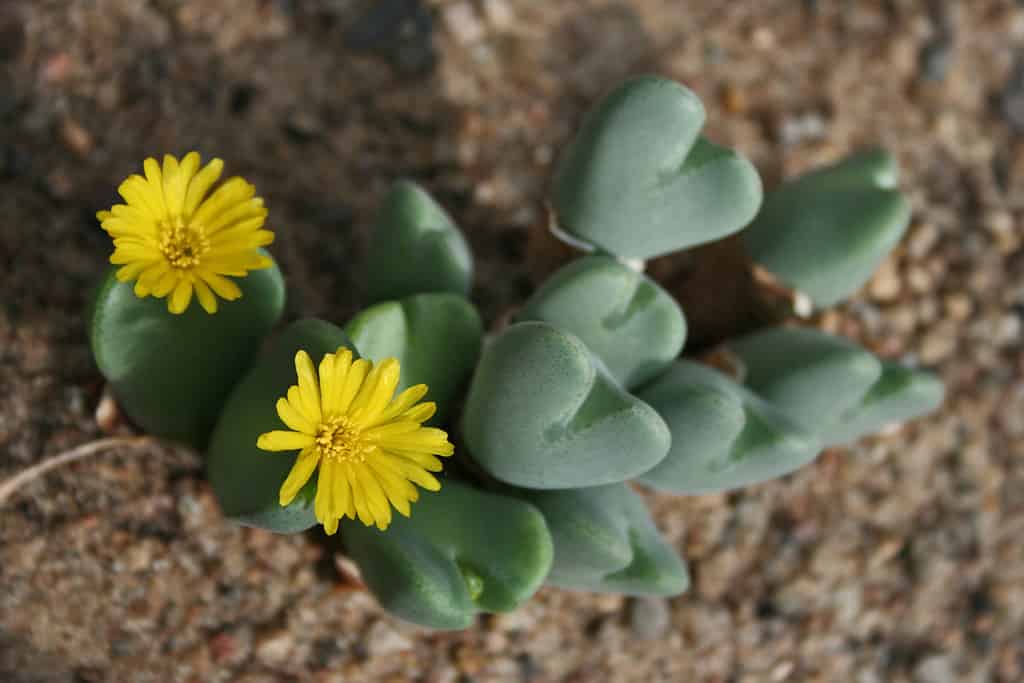
has two lobe-like leaves that split as it grows and produces bright yellow or white flowers.
©iStock.com/Myroslav
7. Argyroderma testiculare
The Argyroderma testiculare is another split rock succulent, recognized by its two rounded leaves that are reminiscent of… well. The plant has a silvery green shade with undertones of blue and blooms in stunning shades of pink and purple and grows in South Africa.
While the name might be a deterrent, these low growers aren’t likely to spread and are easy to care for. They’re also a rare breed of split rock succulent, and the name is a fantastic conversation piece. Discoverer N.E. Brown (a botanist) clearly had a sense of humor.
The rarity of the Argyroderma testiculare makes it a desirable collector’s item among plant enthusiasts for ornamental gardens. Unlike other split rock succulents, this species prefers direct sunlight. However, it’s important to gradually acclimatize your succulent to prevent shock or scorching. Use well-draining soil and propagate with offsets.
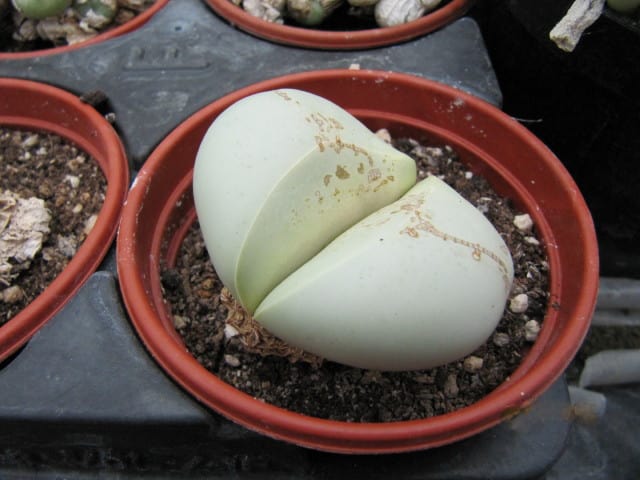
The split rock succulent
Argyroderma testiculareis rare but can make for a great conversation piece.
©Leonora Enking, CC BY-SA 2.0 via Wikimedia Commons – License
8. Lapidaria margaretae
The Lapidaria margaretae is a stunning plant that stands out from other split rock succulents. This slow-growing, compact plant is native to the arid regions of the Little Karoo in South Africa, earning it the alternate name “Karoo Rose.”
The Karoo Rose is multifaceted, with leaves growing geometrically. The thick, fleshy leaves are a vibrant green color, with hints of purple and pink along the edges. The Lapidaria margaretae blooms with yellow flowers, which complement the hued leaves below.
While this plant looks delicate, it’s quite resilient in extreme temperatures. The Lapidaria margaretae prefers bright, direct sunlight and ample heat to thrive. It’s better to underwater this succulent than to risk overwatering it. You can propagate via offshoots.
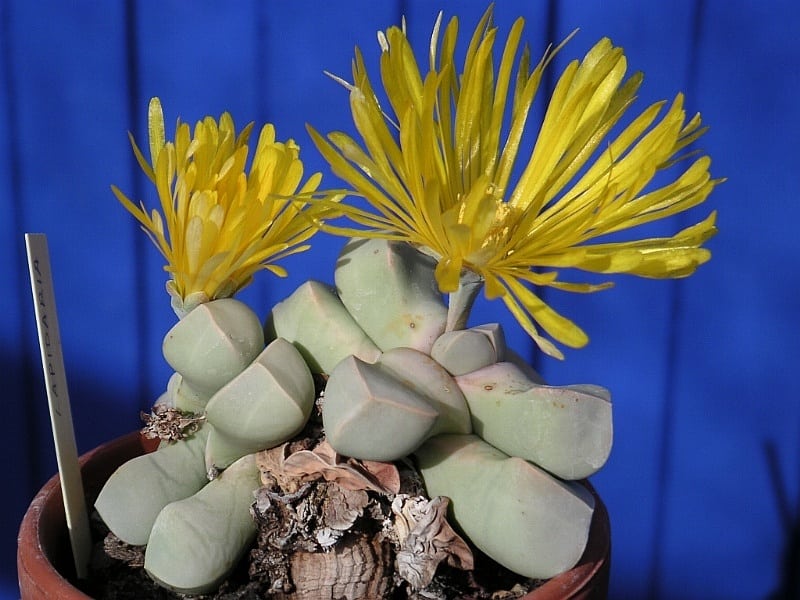
has green thick, fleshy leaves with purple and pink edges, complimented by yellow blooms.
©Jean-Jacques MILAN, CC BY-SA 3.0 via Wikimedia Commons – License
9. Gibbaeum haagei
Another South African gem, the Gibbaeum haagei, also known as another “Living Pebble” or “Haage’s Gibbaeum,” is another succulent often categorized as a split rock. What sets this beauty apart is its asymmetry. While most split rocks are even and balanced, one side of this low-grower tends to be taller than the other.
The light green leaves have soft pink tips, and grow in an abstract formation. With proper care — well-draining soil and bright, indirect sunlight — Haage’s Gibbaeum will produce pink, white, or yellow flowers in the summer, adding a splash of color to its otherwise monochromatic rosette. Propagate this beauty by separating offsets or taking leaf cuttings.
10. Titanopsis calcarea
The Titanopsis genus is home to “Giant Living Stones.” Despite the name, Titanopsis calcarea is small and compact like the other split rock succulents on this list. Sometimes called the Limestone Titanopsis or Concrete Leaf, the Titanopsis calcarea is a unique breed that grows along limestone cliffs in South Africa. Its coloration and markings reflect its habitat.
This succulent’s leaves grow in a rosette pattern and are thick and fleshy with a dusty, grayish-green color. The leaves are covered in a thick layer of powdery wax, which gives them a textured, dusty appearance. The edges are mottled and look similar to limestone or concrete pathways.
With proper care, the Titanopsis calcarea will produce a lovely yellow flower with a wide, white center. These bright flowers attract pollinators. Consider moving your potted Concrete Leaf outdoors during the summer months.
This sun-loving succulent prefers bright, direct sunlight and infrequent watering. Propagate this plant through leaf or stem cuttings using the same well-draining soil as the parent plant to prevent root rot.
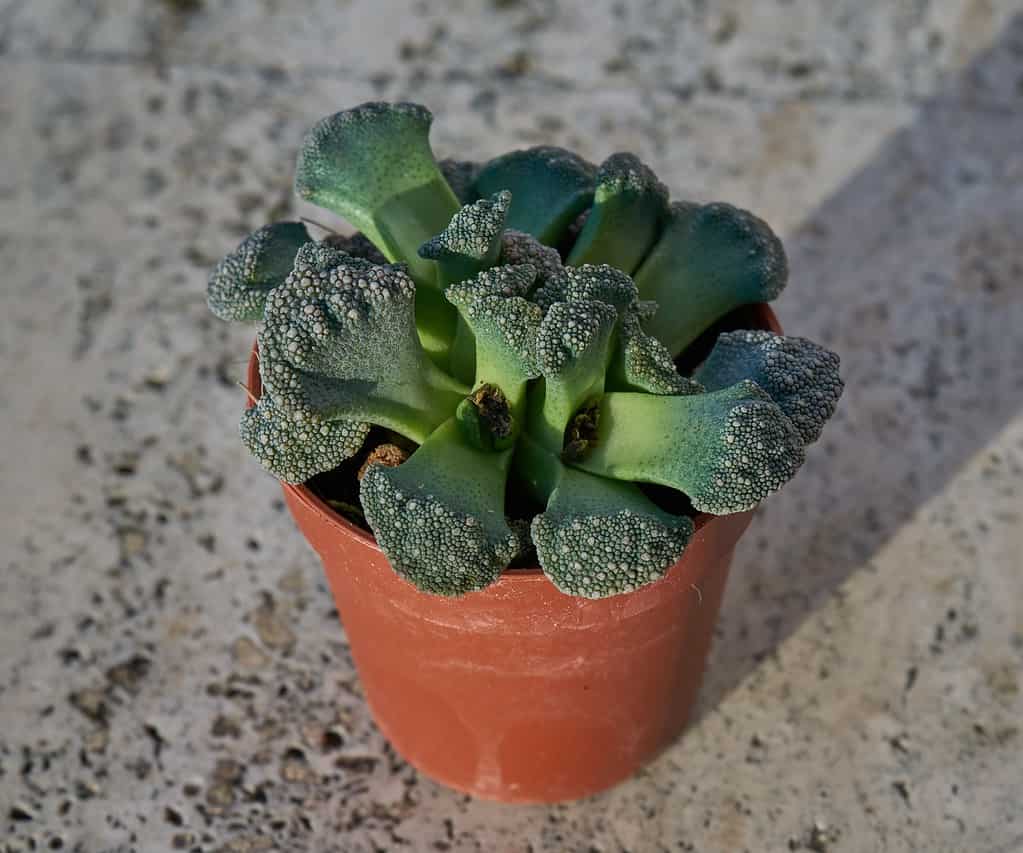
has a texture and markings that reflect its native habitat along limestone cliffs.
©Chiara V/Shutterstock.com
The photo featured at the top of this post is © Sonia Bonet/Shutterstock.com
Thank you for reading! Have some feedback for us? Contact the AZ Animals editorial team.






